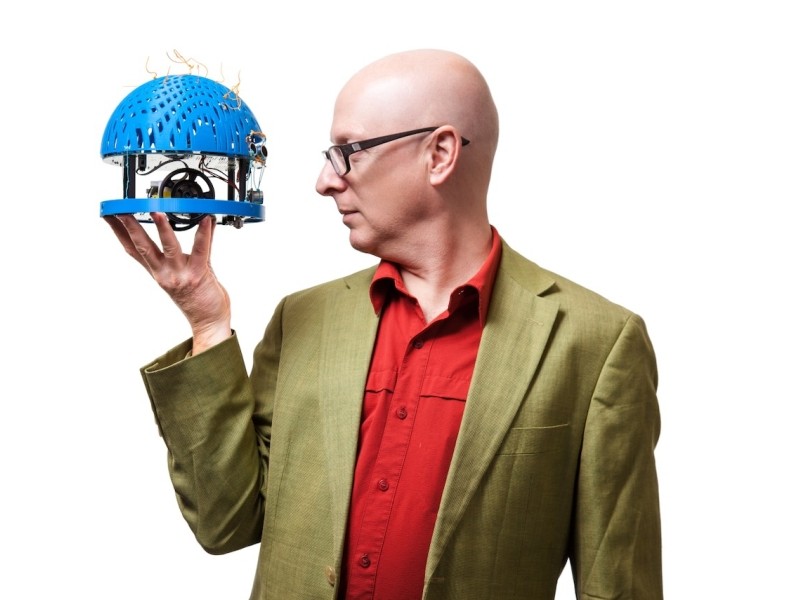
Jason Nolan
Jason Nolan is autistic, the John C. Eaton Chair in Social Innovation and Entrepreneurship and associate professor in Early Childhood Studies at Toronto Metropolitan University. Nolan directs the Responsive Ecologies Lab (RE/Lab) and the Experiential Design and Generative Environments (EDGE) lab and is the Associate Director ECS responsible for our Lab Schools.
Nolan's background in designing adaptations for disabled children stems from a perspective of design initiated by children and their families with the goal of supporting their sensory exploration of the world around them and the communication of their goals, interests and needs to their carers. Nolan's research approach focuses on reconceptualizing music education and exploration of acoustic sensory information in early learning environments from a social justice lens of equity, diversity and inclusion. Nolan's present work is on the missing modality of auditory sensory play and exploration with DIY electronic and found objects and innovations in pedagogical approaches for marginalized communities through three SSHRC funded projects: Canadian Accessible Musical Instrument Network, Facilitating Anti-Ableist Remote Music Making and Sounding off: Learning, communicating and making sense with sound.
- Sound and learning
- Learning with materials
- Social Innovation and Entrepreneurship
- Community Music
- Electronic Music
- Canadian Accessible Musical Instrument Network (external link, opens in new window)
- Neurotypicality
Google Scholar (external link, opens in new window)
Books (Selected):
- Weiss, J., Nolan, J., Hunsinger, J., & Trifonas, P. (2006). The international handbook of virtual learning environments. Springer Academic Publishers.
Chapters (Selected):
- Thumlert, K., Nolan, J., Chan, H., McBride, M. (Submitted). Strange Play: Parametric Design and Modular Learning. In Patch Up!: Exploring synthetic sound and modular thought, A. Kitzman, C. Thorén, E. Engström and E. Teboul (Eds.). Routledge.
- Nolan, J., & McBride, M. (Submitted). First Rack: A multi-modal discourse analysis of Eurorack module design affordances. In Patch Up!: Exploring synthetic sound and modular thought, A. Kitzman, C. Thorén, E. Engström and E. Teboul (Eds.). Routledge.
- Thumlert, K., & Nolan, J. (2020). Angry noise: Recomposing music pedagogies in indisciplinary modes. In P. Trifonas (Ed.), Handbook of Theory and Research in Cultural Studies and Education. Springer.
- Cole, J., & Nolan J. (2019). GimpGirl: Insider perspectives on technology and the lives of disabled women. In B. Haller, G. Goggin & K. Ellis (Eds.), Routledge Companion to Disability and Media (pp. 233-242). Routledge.
- Mann, S., Nolan, J., & Wellman, B. (2018). Sousveillance: Inventing and using wearable computing devices for data collection in surveillance environments. In T. Monahan & D. Murakami Wood (Eds.), Surveillance Studies: A Reader (pp. 347-350). Oxford University Press.
- McBride, M., & Nolan, J. (2018). Situating olfactory literacies: An intersensory pedagogy by design. In V. Henshaw, K. MacLean, D. Medway, C. Perkins & G. Warnaby (Eds.), Designing with smell: practices, techniques and challenges (pp. 187-196). Routledge.
- Nolan, J., & McBride, M. (2015). Embodied semiosis: Autistic 'stimming' as sensory praxis. In P. Trifonas, (Ed.), The International Handbook of Semiotics (pp. 1069-1078). Springer.
Articles (Selected):
- Thumlert, K., Tomin, B., Nolan, J., McBride, M., Lotherington, H., Boreland, T. (Accepted). Critical algorithmic literacies and the modulation of attention and learning in the age of AI. Digital Culture Education.
- Thumlert, K., Nolan, J., Chan, H. (2021). Together apart: Sound communities in the virtual age of COVID-19. Journal of Music, Health, and Wellbeing, Autumn, 1-15.
- Nolan, J. (2020). (Self)Interview with an Autistic: Intrinsic interest and learning with and about music and the missing modality of sound. Canadian Music Educators.
- Thumlert, K., Nolan, J., & Harley, D. (2020). Sound beginnings: Learning, communicating, and making sense with sound. Music Educators Journal, 107(2), 66-69. https://doi.org/10.1177/0027432120952081 (external link, opens in new window)
- Bellucci, A., Nolan, J., & Di Santo, A. (2018). Research in the wild(s): Opportunities, affordances and constraints doing assistive technology field research in underserved areas. Disability Studies Quarterly, 38(4). https://doi.org/10.18061/dsq.v38i4.5934 (external link, opens in new window)
- Nolan, J., & McBride, M. (2014). Beyond gamification: reconceptualizing game-based learning in early childhood environments. Information, Communication & Society, 17(5), 594-608. https://doi.org/10.1080/1369118x.2013.808365 (external link, opens in new window)
Selected Media
- Gaston, R. & Eldar, T. (July 25, 2022). Electronic Music: Allen Strange's Classic Book Reissued. Jason Nolan on Revitalizing Strange's Text + Kickstarter Details. Perfect Circuit.
https://www.perfectcircuit.com/signal/allen-strange-electronic-music-kickstarter (external link, opens in new window) - Frequency Freaks. (May, 2022). Introducing Allen Strange, Electronic Music: Systems, Techniques and Controls. https://www.youtube.com/watch?v=4Idc7WoFRmY (external link, opens in new window)
- Frequency Freaks. (May, 2020). How we learn. https://www.youtube.com/watch?v=B4NmYVbYDlI (external link, opens in new window)
- CBC Arts. (2016). Disrupting Design: Crafty Cardboard Design Activism for Special Needs Children. https://www.youtube.com/watch?v=_mnYndtawuI (external link, opens in new window)
Composer, Performer
- Nolan, J. (2022). Contra Quadra. Frequency Freaks Meetup - April 2022. https://www.youtube.com/watch?v=XSKKOW_xOEY&t=48s (external link, opens in new window)
- Nolan, J. (2021). Ponderous Encroachments of Sand in Detail. Frequency Freaks Meetup - May 2021. https://www.youtube.com/watch?v=GCBepESBjAc (external link, opens in new window)
- Nolan, J. (2021). Unanticipated Performance: OneCV No Waiting. Frequency Freaks Meetup - April 2021 https://www.youtube.com/watch?v=kKk_uRsHxbE (external link, opens in new window)
- Nolan, J., Palumbo, M., and Green, B. (2020). Frequency Freaks Workshop June 2020 – Collaboration. June 13, 2020. https://youtu.be/Ne6IeREad38?t=2937 (external link, opens in new window)
- Nolan, J. (2020). They are resilient. 3-Module Challenge Fundraising Compilation - Toronto Edition. H. Chan (producer). Bandcamp. https://bachelard.bandcamp.com/track/they-are-resilient (external link, opens in new window) [Digital Download]
- Nolan, J. (2020). Maths, Magneto and Triple Sloths. Frequency Freaks’ Monthly Meetup, December 12, 2020. https://youtu.be/FMjbBJ1YXc4 (external link, opens in new window)
Invited Presentations
- Aging Autistically: What happens when you still haven’t grown up? Autism Canada Au-Some Conference, Autism Canada, Toronto, October, 22, 2022
- Individualizable Designs: Helping Children Build Tools to Explore their Worlds. Symposium on Family Learning, Inclusion and the Value of Play in Museums. Canadian Children’s Museum at the Canadian Museum of History, Ottawa, December 4, 2019
- User-Initiated Design: tuning spaces as social technology. Rockefeller Centre, Bellagio, Italy, November 9, 2014.